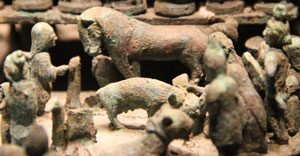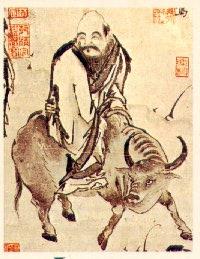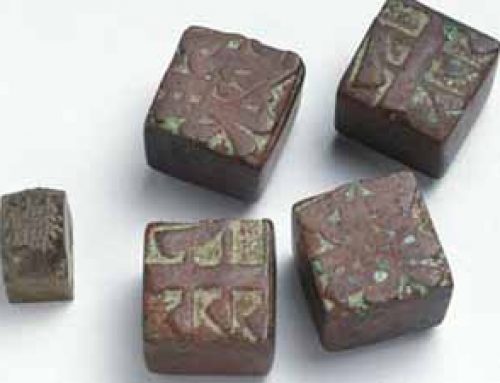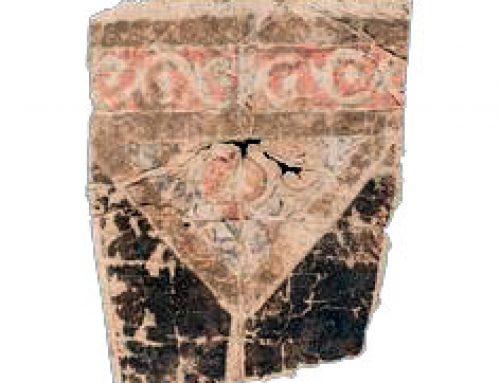
Ancient China religion: Han dynasty animal sacrifice (ca. 200 BC-200 AD)
China’s ancestor worship
In the Shang Dynasty (about 2000 BC), the earliest period we know much about, people in China worshipped a lot of different gods – weather gods and sky gods, and also a higher god who ruled over the other gods, called Shang-Ti.
Who are the Chinese gods?
More about the Shang Dynasty
All our articles about China
People who lived during the Shang Dynasty also believed that their ancestors – their parents and grandparents – became like gods when they died. They believed that their ancestors wanted to be worshipped too, like gods. Each family worshipped their own ancestors. To get the gods on their side, they sacrificed animals to them.
What was animal sacrifice?

Early Chinese writing: an oracle bone with Chinese characters written on it
Oracle bones and religion in ancient China
Around 1500 BC, people began to use written oracle bones to try to find out what was going to happen in the future.
By the time of the Zhou Dynasty (about 1100 BC), the Chinese were also worshipping a natural force called t’ien, which we usually translate as Heaven. Like Shang-Ti, Heaven ruled over all the other gods. Heaven also decided who would be the Emperor or Empress of China.
What was the Zhou Dynasty?
The Mandate of Heaven
The emperor or empress could only rule as long as he or she had the Mandate of Heaven (as long as Heaven wanted him or her to rule). You knew when the emperor or empress had lost the Mandate of Heaven because somebody else would overthrow them and become the new emperor or empress.
Around 600 BC, under the Eastern Zhou Dynasty, and for the next two hundred years, there were a lot of new ideas in Chinese religion. The first big empires were forming. Philosophers responded to the idea of bigger nations with bigger religious ideas.
What is an empire?
History of philosophy

Later portrait of Lao Tzu
Taoism and Chinese religion
First, a Chinese philosopher named Lao Tzu (who may be mythical) created the philosophy of Taoism. Taoism became very popular. Taoism holds that people should not try to get their way by force. Instead, they should use compromise and natural forces to find their way.
Taoism is partly a philosophy, and partly a religious faith. Taoists believe that there is a universal force flowing through all living things. Respecting that force is essential to a happy life. Taoists also didn’t think sacrificing animals to the gods was a good idea. So sacrifice gradually went out of fashion in China (as well in most of the rest of Asia, Africa, and Europe)
How did sacrifice go out of fashion?
More about Taoism
Confucianism in ancient China
Not long after Lao Tzu, another Chinese scholar called Confucius created a different philosophical system we call Confucianism. Confucianism disagreed with Taoism but also became very popular.
More about Confucianism
Who was Confucius?
Confucianism holds that people should do their duty. They should follow their leaders and the gods faithfully. Order is the way to peace. If everyone just does what they are told, and what they are supposed to do, there won’t be any fighting and nobody will be upset. Naturally Confucius supported traditional animal sacrifice, but people gradually stopped doing it anyway.
Mo Tzu and Legalism
There were two other important philosophical schools of this period. One was started by Mo Tzu, which suggested that the way to happiness was for everyone to treat all other people as well as they treated their own families.
The other was Legalism (a kind of Confucianism), which believed that people were all basically bad, and needed to be kept in line by strict laws and harsh punishments in order to create order and peace. Legalism was very important in the way the Qin Dynasty worked (about 220 BC). The Qin are the ones who built the Great Wall of China, to keep out bad foreigners.
More about the Qin Dynasty
What was going on in the 200s BC?
The Qingming Festival
As the Silk Road spread new religious ideas, people in Han Dynasty China started to celebrate the spring Qingming festival.
What is the Silk Road?
What’s the Qingming festival?
All about the Han Dynasty
Many parts of the Qingming Festival, like dyeing eggs, came from West Asian festivals. But these new philosophies and festivals did not end the old religious practices. Everybody kept on worshipping their ancestors and the traditional Chinese gods, and they kept on believing in the Mandate of Heaven.
History of Easter eggs
Who are the Chinese gods?
Medieval Chinese religion – Buddhism comes to China
Learn by doing: Chinese Garden Project
Bibliography and further reading about Chinese religion:
One World, Many Religions: The Ways We Worship, by Mary Pope Osborne (1996). .
The Gods and Goddesses of Ancient China, by Leonard Everett Fisher (2003). . One page for each god, with lots of pictures and some historical context.
Five Heavenly Emperors: Chinese Myths of Creation, by Song Nan Zhang (1994). Stories .
Chinese Mythology A to Z, by Jeremy Roberts (2004).
Dragons and Demons : Myths of China, by Stewart Ross (1998). A few Chinese stories, retold .
Dragons, Gods and Spirits from Chinese Mythology, by Tao Sanders (1983). More of a child’s encyclopedia.





this is a kinda helpful
thank you so much i found nothing
What were you looking for? I’d be happy to help you.
Oh thanks!!
I am doing a project on ancient china and this information helped me a lot thank you so much Karen.
I’m glad we could help, Marcus!
this site helped a lot! Thx!!
Please write a sequence note on religious tradition if ancient chaina.
Sorry, I’m not understanding what you are asking for?
did not help at all
That’s too bad! What did you want to know? I’d be happy to answer your question.
this site … kinda helped!
Happy to hear it! Please feel free to ask if you have more questions.